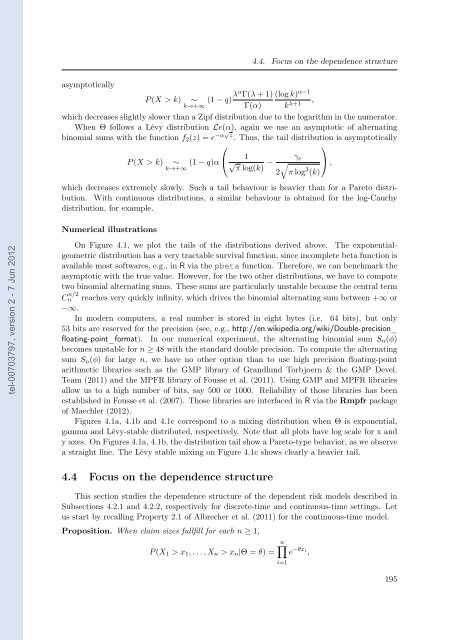Etude des marchés d'assurance non-vie à l'aide d'équilibres de ...
Etude des marchés d'assurance non-vie à l'aide d'équilibres de ...
Etude des marchés d'assurance non-vie à l'aide d'équilibres de ...
Create successful ePaper yourself
Turn your PDF publications into a flip-book with our unique Google optimized e-Paper software.
tel-00703797, version 2 - 7 Jun 2012<br />
4.4. Focus on the <strong>de</strong>pen<strong>de</strong>nce structure<br />
asymptotically<br />
P (X > k) ∼<br />
k→+∞ (1 − q)λα Γ(λ + 1) (log k)<br />
Γ(α)<br />
α−1<br />
kλ+1 ,<br />
which <strong>de</strong>creases slightly slower than a Zipf distribution due to the logarithm in the numerator.<br />
When Θ follows a Lévy distribution Le(α), again we use an asymptotic of alternating<br />
binomial sums with the function f2(z) = e −α√ z . Thus, the tail distribution is asymptotically<br />
⎛<br />
P (X > k) ∼ (1 − q)α ⎝<br />
1<br />
γe<br />
√ − <br />
k→+∞ π log(k)<br />
2 π log 3 ⎞<br />
⎠ ,<br />
(k)<br />
which <strong>de</strong>creases extremely slowly. Such a tail behaviour is hea<strong>vie</strong>r than for a Pareto distribution.<br />
With continuous distributions, a similar behaviour is obtained for the log-Cauchy<br />
distribution, for example.<br />
Numerical illustrations<br />
On Figure 4.1, we plot the tails of the distributions <strong>de</strong>rived above. The exponentialgeometric<br />
distribution has a very tractable survival function, since incomplete beta function is<br />
available most softwares, e.g., in R via the pbeta function. Therefore, we can benchmark the<br />
asymptotic with the true value. However, for the two other distributions, we have to compute<br />
two binomial alternating sums. These sums are particularly unstable because the central term<br />
C n/2<br />
n reaches very quickly infinity, which drives the binomial alternating sum between +∞ or<br />
−∞.<br />
In mo<strong>de</strong>rn computers, a real number is stored in eight bytes (i.e. 64 bits), but only<br />
53 bits are reserved for the precision (see, e.g., http://en.wikipedia.org/wiki/Double-precision_<br />
floating-point_format). In our numerical experiment, the alternating binomial sum Sn(φ)<br />
becomes unstable for n ≥ 48 with the standard double precision. To compute the alternating<br />
sum Sn(φ) for large n, we have no other option than to use high precision floating-point<br />
arithmetic libraries such as the GMP library of Grandlund Torbjoern & the GMP Devel.<br />
Team (2011) and the MPFR library of Fousse et al. (2011). Using GMP and MPFR libraries<br />
allow us to a high number of bits, say 500 or 1000. Reliability of those libraries has been<br />
established in Fousse et al. (2007). Those libraries are interfaced in R via the Rmpfr package<br />
of Maechler (2012).<br />
Figures 4.1a, 4.1b and 4.1c correspond to a mixing distribution when Θ is exponential,<br />
gamma and Lévy-stable distributed, respectively. Note that all plots have log scale for x and<br />
y axes. On Figures 4.1a, 4.1b, the distribution tail show a Pareto-type behavior, as we observe<br />
a straight line. The Lévy stable mixing on Figure 4.1c shows clearly a hea<strong>vie</strong>r tail.<br />
4.4 Focus on the <strong>de</strong>pen<strong>de</strong>nce structure<br />
This section studies the <strong>de</strong>pen<strong>de</strong>nce structure of the <strong>de</strong>pen<strong>de</strong>nt risk mo<strong>de</strong>ls <strong><strong>de</strong>s</strong>cribed in<br />
Subsections 4.2.1 and 4.2.2, respectively for discrete-time and continuous-time settings. Let<br />
us start by recalling Property 2.1 of Albrecher et al. (2011) for the continuous-time mo<strong>de</strong>l.<br />
Proposition. When claim sizes fullfill for each n ≥ 1,<br />
P (X1 > x1, . . . , Xn > xn|Θ = θ) =<br />
n<br />
e −θxi ,<br />
i=1<br />
195
















